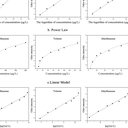Occurrence of antibiotics in water, sediments, aquatic plants, and animals from Baiyangdian Lake in North China.
Sleutelwoorden
Abstract
This study investigated the presence and distribution of 22 antibiotics, including eight quinolones, nine sulfonamides and five macrolides, in the water, sediments, and biota samples from Baiyangdian Lake, China. A total of 132 samples were collected in 2008 and 2010, and laboratory analyses revealed that antibiotics were widely distributed in the lake. Sulfonamides were the dominant antibiotics in the water (0.86-1563 ng L(-1)), while quinolones were prominent in sediments (65.5-1166 μg kg(-1)) and aquatic plants (8.37-6532 μg kg(-1)). Quinolones (17.8-167 μg kg(-1)) and macrolides [from below detection limit (BDL) to 182 μg kg(-1)] were often found in aquatic animals and birds. Salvinia natans exhibited the highest bioaccumulation capability for quinolones among three species of aquatic plants. Geographical differences of antibiotic concentrations were greatly due to anthropogenic activities. Sewage discharged from Baoding City was likely the main source of antibiotics in the lake. Risk assessment of antibiotics on aquatic organisms suggested that algae and aquatic plants might be at risk in surface water, while animals were likely not at risk.


